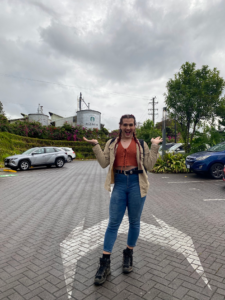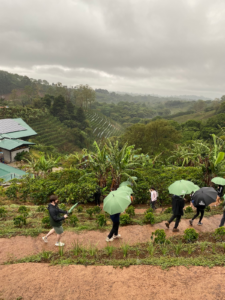From utter obscurity to a massive tourist destination, the town of La Fortuna, located in Northern Costa Rica and built after the 1968 Arenal volcanic eruption, which claimed the lives of 87 locals, now boasts an average of 1.5 million visitors yearly.
During its most famous dry season, tourists can see smoke billowing from the top during the day or basaltic lava flowing from the west side during the night. As a byproduct of such magnificent natural occurrences, through an increase in tourist revenue, it is interesting to examine the intersection between how people produce crops and also increase tourist revenue.


Looking specifically at agriculture and the excellent soil for cropping that Costa Rica continues to possess, Costa Rica itself, according to The Tico Times( Costa Rica’s Leading English Language Newspaper since 1956), has been the pinnacle of cacao farming and harvesting, dating as far back as pre-Columbian times and the reason for this is because of the mixing of warm and moist climate that Costa Rica has to offer, in addition to the nutrients which Volcan Arenal produces naturally.
While Costa Rica is no longer the highest international producer of chocolate, this has not stopped Costa Rica from shifting its focus from agriculture to agritourism. All along the streets of La Fortuna, I saw multiple posters and billboards advertising chocolate farm tours. One, which I did not get the opportunity to visit, is called Eden Chocolate Tour.
The farm includes specific tours into the chocolate farms where tourists are able to learn and see firsthand how cacao trees are harvested and grown. Following the agricultural aspect, the tourists are taken to the kitchen, where they are taught how to create chocolate treats and are able to take home their chocolate creations and enjoy them at home.


When discussing the topic of agriculture within Costa Rica, one would be remiss without mentioning the beloved crop, the coffee tree. First planted and harvested on Costa Rican soil towards the end of the 1700s, according to the Embassy of Costa Rica in Singapore, due to the soil within this country being deemed as perfect due to the environment, which is the same reason cacao trees flourished. The volcanic soil is high in magnesium and potassium, which when mixed with the moist weather, creates incredibly fertile soil. Coffee trees soon caught the attention of the Costa Rican government as they identified it as the crop that could turn the country’s financial situation around (Embassy of Costa Rica in Singapore). Soon after, farmers were given free land to plant and harvest coffee solely.

In 2013, Starbucks purchased a 600-acre coffee farm located near Volcan Poas, which soon became Hacienda Alsacia, the global headquarters with a focus on agronomy research and development.

The first thing explained to us on this tour, which I found the most interesting, was that everything is done onsite from start to finish. This process incorporates the planting, growing, harvesting, and processing of coffee beans into coffee powder. This farm only produces a small amount of coffee each year since processed coffee beans are utilized for research purposes, with a tiny portion being taken to be sold as coffee drinks at the onsite Starbucks Cafe. The main focus of the production of crops at this site is to utilize the harvested coffee to better engineer more beneficial and effective coffee techniques.

In addition to research, Hacienda Alsacia conducts tours in order to inform tourists of the process to plant, grow and make the coffee they love so much. Now while I personally enjoy my coffee with milk and creamer, it was very interesting to learn that the traditional dark roast coffee requires a basic 5 years for the coffee tree to begin to produce coffee beans for the next 12 years. The tour guide explained that since the opening of this research facility, new coffee seeds were modified to cut down the growing process to 2 years instead of 5; which allows for more years of harvest. The importance of this research lies in the growing and developing economic status of local farms as producing more coffee beans in a short period of time allows for a more significant margin of profit. In addition to profit, farmers are provided a safety net if the environment experiences a negative turn of events that limits agricultural production.


The intersecting relationality between both the coffee and chocolate farms located in Costa Rica is that the citizens and farmers of the regions were able to take advantage of the rich soil and nutrients to turn a profit not just in agriculture, but tourism as well. Taking full advantage in order to ensure the most profitable outcome, the farmers in the regions understand that for many tourists, this is not just about seeing coffee grown and chocolate made, but rather experiencing first hand these new experiences and going home with stories.
